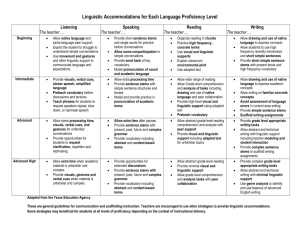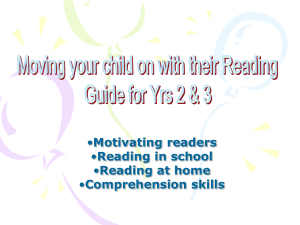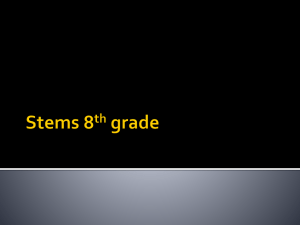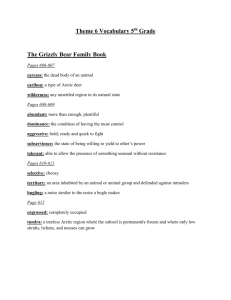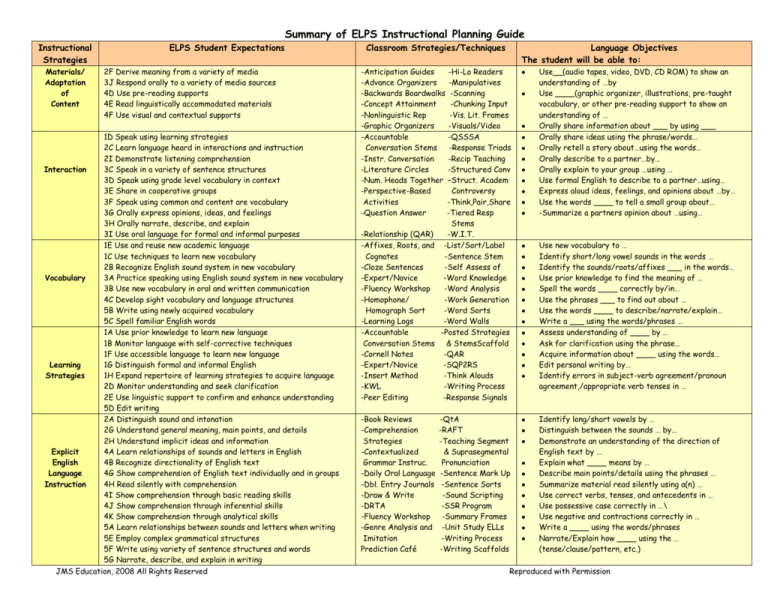
Summary of ELPS Instructional Planning Guide
Instructional
Strategies
Materials/
Adaptation
of
Content
ELPS Student Expectations
2F Derive meaning from a variety of media
3J Respond orally to a variety of media sources
4D Use pre-reading supports
4E Read linguistically accommodated materials
4F Use visual and contextual supports
1D Speak using learning strategies
2C Learn language heard in interactions and instruction
2I Demonstrate listening comprehension
Interaction
3C Speak in a variety of sentence structures
3D Speak using grade level vocabulary in context
3E Share in cooperative groups
3F Speak using common and content are vocabulary
3G Orally express opinions, ideas, and feelings
3H Orally narrate, describe, and explain
3I Use oral language for formal and informal purposes
1E Use and reuse new academic language
1C Use techniques to learn new vocabulary
2B Recognize English sound system in new vocabulary
Vocabulary
3A Practice speaking using English sound system in new vocabulary
3B Use new vocabulary in oral and written communication
4C Develop sight vocabulary and language structures
5B Write using newly acquired vocabulary
5C Spell familiar English words
1A Use prior knowledge to learn new language
1B Monitor language with self-corrective techniques
1F Use accessible language to learn new language
Learning
1G Distinguish formal and informal English
Strategies
1H Expand repertoire of learning strategies to acquire language
2D Monitor understanding and seek clarification
2E Use linguistic support to confirm and enhance understanding
5D Edit writing
2A Distinguish sound and intonation
2G Understand general meaning, main points, and details
2H Understand implicit ideas and information
Explicit
4A Learn relationships of sounds and letters in English
English
4B Recognize directionality of English text
Language
4G Show comprehension of English text individually and in groups
Instruction
4H Read silently with comprehension
4I Show comprehension through basic reading skills
4J Show comprehension through inferential skills
4K Show comprehension through analytical skills
5A Learn relationships between sounds and letters when writing
5E Employ complex grammatical structures
5F Write using variety of sentence structures and words
5G Narrate, describe, and explain in writing
JMS Education, 2008 All Rights Reserved
Classroom Strategies/Techniques
Language Objectives
The student will be able to:
-Anticipation Guides
-Hi-Lo Readers
-Advance Organizers
-Manipulatives
-Backwards Boardwalks -Scanning
-Concept Attainment
-Chunking Input
-Nonlinguistic Rep
-Vis. Lit. Frames
-Graphic Organizers
-Visuals/Video
-Accountable
-QSSSA
Conversation Stems
-Response Triads
-Instr. Conversation
-Recip Teaching
-Literature Circles
-Structured Conv
-Num. Heads Together –Struct. Academ
-Perspective-Based
Controversy
Activities
-Think,Pair,Share
-Question Answer
-Tiered Resp
Stems
-Relationship (QAR)
-W.I.T.
-Affixes, Roots, and -List/Sort/Label
Cognates
-Sentence Stem
-Cloze Sentences
-Self Assess of
-Expert/Novice
-Word Knowledge
-Fluency Workshop
-Word Analysis
-Homophone/
-Work Generation
Homograph Sort
-Word Sorts
-Learning Logs
-Word Walls
-Accountable
-Posted Strategies
Conversation Stems & StemsScaffold
-Cornell Notes
-QAR
-Expert/Novice
-SQP2RS
-Insert Method
-Think Alouds
-KWL
-Writing Process
-Peer Editing
-Response Signals
Use new vocabulary to …
Identify short/long vowel sounds in the words …
Identify the sounds/roots/affixes ___ in the words…
Use prior knowledge to find the meaning of …
Spell the words ____ correctly by/in…
Use the phrases ___ to find out about …
Use the words ____ to describe/narrate/explain…
Write a ___ using the words/phrases …
Assess understanding of ____ by …
Ask for clarification using the phrase…
Acquire information about ____ using the words…
Edit personal writing by…
Identify errors in subject-verb agreement/pronoun
agreement,/appropriate verb tenses in …
-Book Reviews
-Comprehension
Strategies
-Contextualized
Grammar Instruc.
-Daily Oral Language
-Dbl. Entry Journals
-Draw & Write
-DRTA
-Fluency Workshop
-Genre Analysis and
Imitation
Prediction Café
Identify long/short vowels by …
Distinguish between the sounds … by…
Demonstrate an understanding of the direction of
English text by …
Explain what ____ means by …
Describe main points/details using the phrases …
Summarize material read silently using a(n) …
Use correct verbs, tenses, and antecedents in …
Use possessive case correctly in …\
Use negative and contractions correctly in …
Write a ____ using the words/phrases
Narrate/Explain how ____ using the …
(tense/clause/pattern, etc.)
-QtA
-RAFT
-Teaching Segment
& Suprasegmental
Pronunciation
-Sentence Mark Up
-Sentence Sorts
-Sound Scripting
-SSR Program
-Summary Frames
-Unit Study ELLs
-Writing Process
-Writing Scaffolds
Use__(audio tapes, video, DVD, CD ROM) to show an
understanding of …by
Use ____(graphic organizer, illustrations, pre-taught
vocabulary, or other pre-reading support to show an
understanding of …
Orally share information about ___ by using ___
Orally share ideas using the phrase/words…
Orally retell a story about…using the words…
Orally describe to a partner…by…
Orally explain to your group …using …
Use formal English to describe to a partner…using…
Express aloud ideas, feelings, and opinions about …by…
Use the words ____ to tell a small group about…
-Summarize a partners opinion about …using…
Reproduced with Permission
ELPS Linguistic Accommodation Planning Guide
Communicating
Gestures
Verbal Cues
Extra Wait Time
Peer Interaction
Use of Native Language
Sequencing
Beginning Students
(A)
Intermediate
(B)
Advanced
Advanced High
Pre-Teaching Vocabulary
Providing Sentence Stems
Modeling & Manipulatives
Visuals & Organizers
Adapted Text
Adapted Writing Tasks
Listening
TEACHER MOVES FOR EACH PROFICIENCY LEVEL
Scaffolding
Allow use of same language peer
native language support
Expect student to struggle to
understand simple
conversations
Use gestures and movement
Provide visuals, slower speech,
verbal cues, simplified language
Preteach vocabulary before
discussions and lectures
Teach phrases for student to
request speakers repeat, slow
down, or rephrase speech
Verbal
Rephrasing
Recasting
Think Alouds
Repetition
Call Backs
Speaking
Reading
Provide short sentence stems and
single words for practice before
conversations
Allow some nonparticipation in simple
conversations
Provide word bank of key
Vocabulary
Model pronunciation of social and
academic vocabulary
Allow extra processing time
Provide sentence stems with simple
sentence structures and tenses
Model and provide practice in
pronunciation of academic terms
Allow extra time when academic
material is complex and
unfamiliar
Provide visual, verbal cues, and
gestures when material is
complex and unfamiliar
Allow extra time after pauses
Provide sentence stems with past,
present, future, and complex grammar
and vocabulary with content-based and
abstract terms
Allow wide range of reading
Allow grade-level comprehension and
analysis of tasks including drawing
and use of native language and peer
collaboration
Provide high level of visual and
linguistic supports with adapted
text and pretaught vocabulary
Allow abstract grade-level reading
comprehension and analysis with
peer support
Provide visual and linguistic supports
using adapted text for unfamiliar
topics
Opportunities for extended
discussions
Provide sentence stems with past,
present, future, and complex grammar
and vocabulary with content-based and
abstract terms
Instructional
Graphic Organizers
Outlines
Key Word Lists
Sentence Starters
Close Sentences
Writing
Organize reading into chunks
Use visual and linguistic supports
Explain classroom environmental
print
Use adapted text
Allow some processing time,
visuals, verbal cues and
gestures for unfamiliar
conversations
Provide opportunities for
student to request
clarification, repetition and
rephrasing
Procedural
Teach, model, practice, then apply
Work as a class, small groups,
partners, then individually
Allow abstract grade-level reading
Provide minimal visual and linguistic
supports
Allow grade level comprehension and
analysis of tasks with peer
collaboration
Allow drawing and use of native
language to express concepts
Allow student to use high frequency
recently memorized, and short, simple
sentences
Provide short, simple sentence stems
with present tense and high frequency
vocabulary
Allow drawing and use of native
language to express concepts
Allow writing on familiar, concrete
topics
Avoid assessment of language errors
in content area writing
Provide simple sentence stems and
scaffolded writing assignments
Provide grade level appropriate
writing tasks
Allow abstract and technical writing
with linguistic support including
teacher modeling and student
interaction
Provide complex sentence stems for
scaffolded writing assignments
Provide complex grade-level
appropriate writing tasks
Allow abstract and technical writing
with minimal linguistic support
Use genre analysis to identify and use
features of advanced English writing
JMS Education, 2008 All Rights Reserved
Reproduced with Permission



